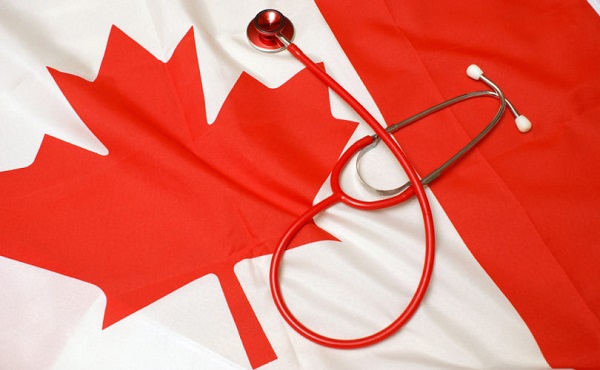Health
3+ million Canadians waiting for basic care as health system crisis continues

From LifeSiteNews
Canada’s health system crisis continues as a new report shows over 3.2 million citizens are stuck waiting for basic care including surgeries, diagnostic scans and appointments with specialists.
Millions of Canadians seeking healthcare have been waitlisted, according to most recent reports.
In an October 24 press release, Canadian think tank SecondStreet reported that over 3.2 million Canadians are still waiting to receive basic healthcare, including surgeries, diagnostic scans and appointments with specialists.
“Despite record health spending by provincial governments to reduce wait times, improvements to waiting lists have been quite sluggish,” said Harrison Fleming, Legislative and Policy Director at SecondStreet.org.
“With more than three million Canadians waiting today – nearly the same number since Canada came out of the pandemic – it’s clear that throwing money at the problem isn’t the answer,” he continued. “Copying policies that work well in universal systems in Europe could help.”
SecondStreet further revealed that their data is incomplete since neither Yukon or Prince Edward Island provided data, meaning the actual number of Canadians awaiting health care is likely closer to 5.1 million patients, or about one in eight Canadians.
According to the data, wait times in Saskatchewan have improved since the “pandemic” as both the number of patients waiting for surgery and diagnostic scans have dropped 22% and 11% respectively.
In Ontario, residents saw surgical waitlist volumes decrease 19%, while diagnostic waitlist volumes rose 32%.
Quebec’s numbers saw a greater improvement, as the province witnessed a 42% decrease in diagnostic waitlist volumes while only a 4% increase in surgical waitlist numbers.
The Maritime provinces provided little to no data, with New Brunswick only reporting a 2% increase in surgery wait times and Newfoundland reporting a 31% drop in diagnostic waitlists. Similarly, Nova Scotia saw a 33.5% drop in those waiting for surgery.
At the same time, British Columbia’s surgical waitlist volume has increased 10%, while 204,737 patients are on waitlists for MRIs, CT Scans, colonoscopies, and other GI endoscopies.
Additionally, Alberta’s surgical and diagnostic waitlists increased 4% and 3% respectively, leaving nearly 200,000 patients waiting for surgical and diagnostic care. However, the province explained that their new data drew from a larger pool of health providers than previously provided.
Finally, in Manitoba, the number of people waiting for surgery and to receive a diagnostic scan increased over 16% to a total of 76,021.
The continued problem with long waits for care comes after years of reports that the medical systems of Canadian provinces are woefully understaffed compared to the population. In May, data revealed that Ontario will need 33,200 more nurses and 50,853 more personal support workers by 2032 to fill the ongoing shortages, figures Premier Doug Ford’s government had asked the Information and Privacy Commissioner to keep secret.
Many have pointed to the fact that the crisis was exacerbated when provinces began levying COVID vaccine mandates as a condition of employment for healthcare workers. While the official number of nurses and other workers relieved of their duties for refusing to take the experimental injections remains uncertain, Raphael Gomez, director of the Centre for Industrial Relations and Human Relations at the University of Toronto, told CTV News that as many as 10 percent of nurses in Ontario, the nation’s most populous province, either quit or retired early as a result of the mandates.
Officials tried to justify the mandates by claiming that the unvaccinated were “unprotected” from COVID while the vaccinated were believed to have immunity from the virus. However, there is overwhelming evidence that the COVID vaccine does not prevent transmission and can also cause a plethora of negative side effects.
Similarly, in February, Health Canada revealed that Canada was short 89,995 doctors, nurses and other front line health care workers, which is double the rate from 2020 before COVID vaccine mandates were imposed.
Currently, wait times to receive care in Canada have increased to an average of 27.7 weeks, leading some Canadians to despair and opt for euthanasia instead of waiting for assistance. At the same time, sick and elderly Canadians who have refused to end their lives via MAiD have reported being called “selfish” by their providers.
Addictions
The Shaky Science Behind Harm Reduction and Pediatric Gender Medicine


By Adam Zivo
Both are shaped by radical LGBTQ activism and questionable evidence.
Over the past decade, North America embraced two disastrous public health movements: pediatric gender medicine and “harm reduction” for drug use. Though seemingly unrelated, these movements are actually ideological siblings. Both were profoundly shaped by extremist LGBTQ activism, and both have produced grievous harms by prioritizing ideology over high-quality scientific evidence.
While harm reductionists are known today for championing interventions that supposedly minimize the negative effects of drug consumption, their movement has always been connected to radical “queer” activism. This alliance began during the 1980s AIDS crisis, when some LGBTQ activists, hoping to reduce HIV infections, partnered with addicts and drug-reform advocates to run underground needle exchanges.
The Bureau is a reader-supported publication.
To receive new posts and support my work, consider becoming a free or paid subscriber.
In the early 2000s, after the North American AIDS epidemic was brought under control, many HIV organizations maintained their relevance (and funding) by pivoting to addiction issues. Despite having no background in addiction medicine, their experience with drug users in the context of infectious diseases helped them position themselves as domain experts.
These organizations tended to conceptualize addiction as an incurable infection—akin to AIDS or Hepatitis C—and as a permanent disability. They were heavily staffed by progressives who, influenced by radical theory, saw addicts as a persecuted minority group. According to them, drug use itself was not the real problem—only society’s “moralizing” norms.
These factors drove many HIV organizations to lobby aggressively for harm reduction at the expense of recovery-oriented care. Their efforts proved highly successful in Canada, where I am based, as HIV researchers were a driving force behind the implementation of supervised consumption sites and “safer supply” (free, government-supplied recreational drugs for addicts).
From the 2010s onward, the association between harm reductionism and queer radicalism only strengthened, thanks to the popularization of “intersectional” social justice activism that emphasized overlapping forms of societal oppression. Progressive advocates demanded that “marginalized” groups, including drug addicts and the LGBTQ community, show enthusiastic solidarity with one another.
These two activist camps sometimes worked on the same issues. For example, the gay community is struggling with a silent epidemic of “chemsex” (a dangerous combination of drugs and anonymous sex), which harm reductionists and queer theorists collaboratively whitewash as a “life-affirming cultural practice” that fosters “belonging.”
For the most part, though, the alliance has been characterized by shared tones and tactics—and bad epistemology. Both groups deploy politicized, low-quality research produced by ideologically driven activist-researchers. The “evidence-base” for pediatric gender medicine, for example, consists of a large number of methodologically weak studies. These often use small, non-representative samples to justify specious claims about positive outcomes. Similarly, harm reduction researchers regularly conduct semi-structured interviews with small groups of drug users. Ignoring obvious limitations, they treat this testimony as objective evidence that pro-drug policies work or are desirable.
Gender clinicians and harm reductionists are also averse to politically inconvenient data. Gender clinicians have failed to track long-term patient outcomes for medically transitioned children. In some cases, they have shunned detransitioners and excluded them from their research. Harm reductionists have conspicuously ignored the input of former addicts, who generally oppose laissez-faire drug policies, and of non-addict community members who live near harm-reduction sites.
Both fields have inflated the benefits of their interventions while concealing grievous harms. Many vulnerable children, whose gender dysphoria otherwise might have resolved naturally, were chemically castrated and given unnecessary surgeries. In parallel, supervised consumption sites and “safer supply” entrenched addiction, normalized public drug use, flooded communities with opioids, and worsened public disorder—all without saving lives.
In both domains, some experts warned about poor research practices and unmeasured harms but were silenced by activists and ideologically captured institutions. In 2015, one of Canada’s leading sexologists, Kenneth Zucker, was fired from the gender clinic he had led for decades because he opposed automatically affirming young trans-identifying patients. Analogously, dozens of Canadian health-care professionals have told me that they feared publicly criticizing aspects of the harm-reduction movement. They thought doing so could invite activist harassment while jeopardizing their jobs and grants.
By bullying critics into silence, radical activists manufactured false consensus around their projects. The harm reductionists insist, against the evidence, that safer supply saves lives. Their idea of “evidence-based policymaking” amounts to giving addicts whatever they ask for. “The science is settled!” shout the supporters of pediatric gender medicine, though several systematic reviews proved it was not.
Both movements have faced a backlash in recent years. Jurisdictions throughout the world are, thankfully, curtailing irreversible medical procedures for gender-confused youth and shifting toward a psychotherapy-based “wait and see” approach. Drug decriminalization and safer supply are mostly dead in North America and have been increasingly disavowed by once-supportive political leaders.
Harm reductionists and queer activists are trying to salvage their broken experiments, occasionally by drawing explicit parallels between their twin movements. A 2025 paper published in the International Journal of Drug Policy, for example, asserts that “efforts to control, repress, and punish drug use and queer and trans existence are rising as right-wing extremism becomes increasingly mainstream.” As such, there is an urgent need to “cultivate shared solidarity and action . . . whether by attending protests, contacting elected officials, or vocally defending these groups in hostile spaces.”
How should critics respond? They should agree with their opponents that these two radical movements are linked—and emphasize that this is, in fact, a bad thing. Large swathes of the public understand that chemically and surgically altering vulnerable children is harmful, and that addicts shouldn’t be allowed to commandeer public spaces. Helping more people grasp why these phenomena arose concurrently could help consolidate public support for reform and facilitate a return to more restrained policies.
Adam Zivo is director of the Canadian Centre for Responsible Drug Policy.
For the full experience, please upgrade your subscription and support a public interest startup.
We break international stories and this requires elite expertise, time and legal costs.
Health
DMSO Heals the Eyes and Transforms Ophthalmology

DMSO’s unique therapeutic properties reveal the unifying thread between many different “incurable” eye diseases.
Story at a Glance:
• DMSO is an “umbrella remedy” capable of treating a wide range of challenging ailments due to its combination of therapeutic properties (e.g., reducing inflammation, improving circulation, and reviving dying cells).
• DMSO has a unique affinity for the eyes, resulting in it (often spontaneously) treating a wide range of visual disorders that frequently cannot be treated with conventional therapeutic options.
• DMSO’s ability to restore circulation, revive dying cells, and stabilize misfolded proteins allows it to treat a variety of retinal diseases (e.g., macular degeneration, diabetic retinopathy or retinitis pigmentosa—in some cases reversing permanent blindness), eliminate visual obstructions (e.g., floaters and cataracts), reverse glaucoma or Fuchs’ dystrophy, and restore normal focus (frequently eliminating the need for glasses).
• DMSO’s anti-inflammatory and antimicrobial properties allow it to treat dry eyes, inflammatory diseases around the eye (e.g., blepharitis, styes, and psoriasis) or within the eye (e.g., iritis, uveitis, conjunctivitis, keratitis), along with bacterial, fungal, parasitic, or viral eye infections such as shingles.
•DMSO’s healing properties also allow it to heal a variety of eye injuries (including severe ones which would otherwise require eye removal), skin issues around the eye (e.g., burns, skin tags, and under-eye bags), and eliminate eye muscle spasms.
•This article will review the extensive data demonstrating DMSO’s efficacy for eye diseases, along with an examination of the most common protocols used for them and other natural approaches that also aid in the treatment of common eye disorders.
Since 2024, I have been working diligently to present the extensive data that DMSO is a remarkable therapeutic that is uniquely suited to treat many highly challenging medical conditions due to its counteracting many root causes of disease (whereas, in contrast, vaccines cause a myriad of health issues by inducing those key drivers of illness). From this, I’ve compiled a series of articles synthesizing thousands of studies that have shown DMSO effectively treats:
- Strokes, paralysis, a wide range of neurological disorders (e.g., Down Syndrome and dementia), and many circulatory disorders (e.g., Raynaud’s, varicose veins, hemorrhoids), which I discussed here.
- A wide range of tissue injuries, such as sprains, concussions, burns, surgical incisions, and spinal cord injuries (discussed here).
- Chronic pain (e.g., from a bad disc, bursitis, arthritis, or complex regional pain syndrome), which I discussed here.
- A wide range of autoimmune, protein, and contractile disorders, such as scleroderma, amyloidosis, and interstitial cystitis (discussed here).
- A variety of head conditions, such as tinnitus, vision loss, dental problems, and sinusitis (discussed here).
- A wide range of internal organ diseases (discussed here).
- Many different respiratory disorders, including asthma and COPD (discussed here)
- Many different gastrointestinal disorders, such as bowel inflammation, cirrhosis, and pancreatitis (discussed here)
- A wide range of skin conditions, such as burns, varicose veins, acne, hair loss, ulcers, skin cancer, and many autoimmune dermatologic diseases (discussed here).
- Many challenging infectious conditions, including chronic bacterial infections, herpes, and shingles (discussed here).
- Many aspects of cancer (e.g., many of cancer’s debilitating symptoms, making cancer treatments more potent, greatly reducing the toxicity of conventional therapies, and turning cancer cells back into normal cells), which I discussed here.
Since the evidence in those articles (along with one on how DMSO can be synergistically combined with pharmaceuticals and another on how DMSO combines with natural therapies) made a compelling case for the use of DMSO, many readers opted to start using it. Many of them, in turn, had remarkable improvements which caused them to recommend DMSO to their peers, and because of all those successes, a widespread interest in DMSO has now emerged.
On one hand, this has been quite surprising to me as the information I publicized has been widely available for decades, but (possibly due to it being impossible to profit off DMSO because of how little it costs) most of the people exposed to this series were not even aware this therapy existed, let alone what DMSO could do. Conversely, the groundswell of interest is not surprising as it’s nearly identical to what happened when DMSO was first discovered in the 1960s and it rapidly became the most popular drug in America—particularly since relatively minimal progress has been made on most of the “incurable” conditions it cured back then. Consider for example this 1980 segment 60 minutes created, which showed the remarkable results generated from the therapeutic use of DMSO and more importantly, the exact same stonewalling and suppression of DMSO from the FDA that we saw throughout COVID-19:
User DMSO Reports
Because of DMSO’s high degree of efficacy, the moment I began the series, I started being flooded with testimonials from readers of the remarkable improvements DMSO had created for them. Before long, I realized I was in a similar situation to what I’d been in throughout COVID-19.
I have long believed one of the core strategies the ruling class always follows is to establish rigid hierarchical systems that have dominion over critical facets of society and then buy out the top of the pyramid, as that provides a relatively low-cost way to control the entire society. In the case of medicine, this has translated to having pharmaceutical compliant individuals (through industry funding and media complicity) be anointed as experts who reinforce the profitable orthodoxy alongside having medical journals only publish things which cater to the existing vested interests.
Because of this, things that are “controversial” (threatening vested interests) are rarely published in a “credible” medium, and as a result, anyone who tries to advocate for them is not listened to; instead, they are chastised for endorsing “unproven” and unscientific beliefs.
When the COVID vaccines hit the market, I had expected they would cause a significant number of chronic issues that would take years to be recognized—so I was quite shocked to be immediately flooded with reports across the country of severe reactions of all types from the vaccine. Because of this, I felt I needed to log them as I knew injuries like these would never get published in medical journals and I wanted to have some type of proof that vaccine injuries were real, so in the future I could present accurate information to skeptical parties. I hence spent an inordinate amount of time interviewing those involved and compiling all of them and after unexpectedly gaining a Substack audience, I published that log, and it went viral because my small sample accurately represented the pattern of vaccine injuries everyone was seeing around them and because more than a year into the COVID vaccine rollout, no one had done anything similar—despite the massive demand for this type of information.
In the process of doing that, I had also received a lot of reports of individuals who appeared to be being injured by COVID vaccine shedding—despite this being “impossible” based on the purported design of the vaccines. As the reports, like those for the COVID-19 vaccine injuries, were consistent in character (and like the vaccines many affected by shedding were understandably desperate for information on the topic) I decided to spend a year compiling thousands of those reports as I knew there would never be a journal willing to touch the subject. Following this, I then produced a synthesis of that data which showed there were clear repeating patterns to mRNA shedding and provided the critical mechanisms to explain this seemingly inexplicable phenomenon. That, in turn, was an inordinate amount of work to do, but succeeded and made many realize shedding is a real risk of the mRNA technology—something which will be critical for opposing future attempts to inject the population with experimental gene therapies.
In the case of DMSO, as I started receiving all of these reports (at a time when I had essentially finished the shedding project), I realized that I had access to a unique dataset that had not previously been available. More importantly, because there were so many different things that DMSO could treat, a dataset like this would likely be the only place much of that therapeutic data could ever be compiled (as no one would ever get around to conducting studies on many of those uses—particularly since the current academic publishing climate is much more hostile to publishing unorthodox research now than it was fifty years ago).
So, over the last 13 months, one of my primary projects has been to compile all the reports I’ve received (which I did in the comments here), and I presently have 4,721 comments—of which I think roughly 3,000 are unique stories of therapeutic benefit people have experienced. In turn, my plan is to eventually compile and synthesize all of that, but as doing that will take at least a month, I’ve held off until the end of the series (so I wouldn’t have to redo it with new data that was subsequently received).
Note: my general sense from all the testimonials I’ve received is that between 80-90% of users have a positive response to using DMSO (which is frankly extraordinary), with lower rates (50%) being seen for certain issues which are harder to correctly treat with DMSO, and give or take 0% success rates being seen for issues DMSO is not thought to treat (suggesting the sample I’m observing is representative of real life data).
Within those comments, while most of the reports I’ve received are consistent with what DMSO is recognized to do (e.g., rapidly eliminating debilitating pain that nothing else had worked on), some were quite extraordinary and not what I’d expected to come across. For example, after I learned a 75 year old reader who’d been blind since birth had regained their sight after using DMSO to treat a sinus issue, I realized his story needed to be shared:
Note: as fate had it, Murray lived about 3 hours away from Rebecca Cunningham, the Texas-based documentary film maker who cured her neighbor’s terminal COPD with nebulized DMSO, after which millions saw Dan’s COPD story.1,2 As DMSO changed her life, she is currently collecting other DMSO testimonials on her Rumble channel and kindly agreed to travel to Murray to film this. If you have a story to share and are ever passing through Wimberley or visiting the hill country in Texas, please reach out to her.
In compiling these reports, I was struck by how many were for the eyes, by how well DMSO worked across an extensive range of eye conditions, and by the fact that, in the majority of cases, it provided better results than could be expected from existing ophthalmology options.
Note: the only well-recognized ophthalmologic conditions I did not receive reports on were amblyopia, strabismus, diabetic retinopathy, keratitis, optic neuritis, retinal detachment, retinopathy of prematurity, chalazions, central retinal vein occlusion (although a reader’s branched retinal vein occlusion responded to DMSO), and eye cancers—many of which, as I will show in this article, existing data sources suggest do respond to DMSO.
Later, while translating the discoveries of the German community, I learned their data matched that of the readers here:
One of the first new adopters of DMSO (circa 2012), began successfully using highly diluted DMSO for eye treatments in his practice. This led to a network of practitioners using DMSO for eye health, accumulating substantial experience, and, in many cases, treating eye issues where the cause could not be determined.
In general, there are a surprising number of successful reports using DMSO eye drops for a wide variety of eye symptoms and diseases. So many, in fact, that I now consider the DMSO eye solution an exceptional “eye care.”
Many users (especially those with heavy screen time) apply DMSO preventively to maintain eye freshness, improve tear quality, and reduce night glare. Positive effects, including improved vision, better tear film, fresher eyes, and reduced night glare, are often reported after the first few applications, enhancing overall eye comfort and function—including in people whom ophthalmologists did not diagnose with any eye conditions.
The positive effects are often reported after the first few applications, but I consider [low dose eye drops] a longer-term option. Due to the excellent diagnostic results and the complete absence of adverse effects from low dose drops (including results from ophthalmologists for a wide range of eye disorders) I increasingly view DMSO eye drops as a preventative measure, eye care for those with (still) healthy eyes, since modern life, particularly excessive screen time, places significant demands on our eyes.
Note: the above was extracted from an AI-generated summary of hundreds of hours of non-English lectures, then further condensed by me and hence not a direct quote (but one that accurately represents the author’s statements).
While this might be difficult to believe, consider a parallel situation. Another umbrella remedy I have been deeply impressed by, ultraviolet blood irradiation (which has many similar therapeutic properties to DMSO), has a vast volume of literature demonstrating its clinical value—including for numerous immensely challenging to treat diseases. Yet, virtually none of the medical profession even knows this therapy exists.
For this reason, we are currently sorting through thousands of UVBI studies, including dozens of studies (many of which were conducted with hundreds of patients) which show UVBI treats a myriad of challenging ophthalmologic conditions such as:
blepharitis,1 keratitis,1 corneal inflammation,1 herpes zoster ophthalmicus,1 traumatic eye infection,1 uveitis,1,2,3,4,5 iridocyclitis,1,2 choroiditis,1 chorioretinopathy,1,2,3,4 choroidal and chorioretinal dystrophy,1,2 macular degeneration,1 retinitis pigmentosa,1,2 retinal contusion,1 retinal ischemia,1,2 retinal and fundus hemorrhages,1,2,3,4 retinal artery and vein occlusions,1,2,3,4,5,6,7,8,9,1
0,11,12,13,14,15 diabetic retinopathy,1 ischemic optic neuropathy,1,2,3,4,5 optic neuritis,1,2,3 optic nerve atrophy (traumatic or inflammatory),1,2,3 encephalopathic vision loss1
Note: in this article, each superscipt number links to either a reader’s story or an applicable study—like the many I listed above (which the ophthalmology profession does not realize exists).
As such, the purpose of this article will be to highlight exactly how DMSO is transforming ophthalmology, along with the supporting data.
The Forgotten Side of Medicine is a reader-supported publication.
To receive new posts and support my work, consider becoming a free or paid subscriber.
To learn more about this newsletter and how others have benefitted from it, click here!
Note: the best review paper on DMSO’s uses in ophthalmology (which is an excellent resource to provide to physicians who are skeptical of using DMSO for the eyes) can be read here.
-

 Business21 hours ago
Business21 hours agoTrans Mountain executive says it’s time to fix the system, expand access, and think like a nation builder
-

 Alberta2 days ago
Alberta2 days agoCoutts border officers seize 77 KG of cocaine in commercial truck entering Canada – Street value of $7 Million
-

 Alberta1 day ago
Alberta1 day agoPremier Smith sending teachers back to school and setting up classroom complexity task force
-

 Business2 days ago
Business2 days agoThe painful return of food inflation exposes Canada’s trade failures
-

 Alberta1 day ago
Alberta1 day agoThousands of Albertans march to demand independence from Canada
-

 Crime1 day ago
Crime1 day agoSuspect caught trying to flee France after $100 million Louvre jewel robbery
-

 Addictions23 hours ago
Addictions23 hours agoThe Shaky Science Behind Harm Reduction and Pediatric Gender Medicine
-

 Business2 days ago
Business2 days agoOttawa Bought Jobs That Disappeared: Paying for Trudeau’s EV Gamble












